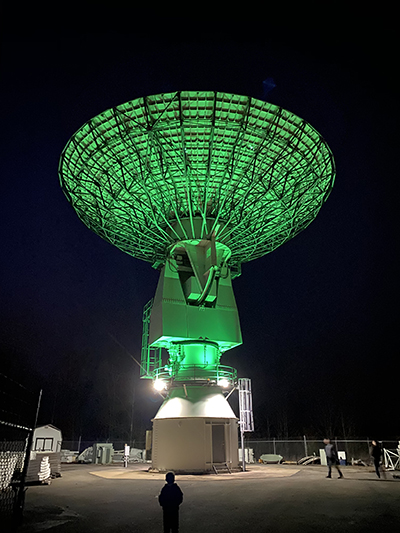College of Science
Morehead State's 21M Antenna to support NASA Deep Space Network
 Morehead State is joining the largest and most sensitive scientific telecommunications system in the world as its 21-meter tracking antenna becomes a NASA Deep Space Network (DSN) affiliate.
Morehead State is joining the largest and most sensitive scientific telecommunications system in the world as its 21-meter tracking antenna becomes a NASA Deep Space Network (DSN) affiliate. Officials from NASA visited MSU's Space Science Center Thursday, Aug. 12, to conduct an operational readiness review for the antenna. The MSU site will be the first non-NASA Deep Space Network affiliated node.
The DNS includes antennas in Barstow, California; Madrid, Spain; and Canberra, Australia. Operated by NASA's Jet Propulsion Laboratory (JPL), the DSN supports NASA’s interplanetary missions. The DSN also provides radar and radio astronomy observations that improve the scientific understanding of the solar system and universe. The DSN sites are spaced roughly 120 degrees longitude apart, permitting constant communication with spacecraft as Earth rotates. Before a distant spacecraft sinks below the horizon at one DSN site, another site can pick up the signal and carry on communicating.
The review will verify that personnel, systems and equipment are trained and ready to support deep space exploration missions. Jeff Kruth, space systems engineer and the technical lead and Dr. Ben Malphrus, principal investigator, led the review for Morehead State University.
"This tells us that on the day of the launch, everybody is going to be just waiting for this rocket to get off the ground, and everyone's going to be ready to support the missions," said Andres Martinez, program executive of Advanced Exploration Systems with NASA. "This is a chance for the students and their professors to showcase all of their work for us and to get feedback from us."
Brad Arnold, project manager of the DNS for JPL, said the partnership between NASA and MSU is mutually beneficial.
"There's a fantastic synergy here," Arnold said. "These are the next generation of engineers and scientists that will be performing space exploration, so that synergy is vital. If we can't motivate and inspire the young people out there, the program's dead."
MSU and NASA have a long-standing partnership. The 21-meter antenna at MSU has been operational since 2006, allowing students to gain valuable skills and experience in researching astrophysics, satellite telecommunications, RF and electrical engineering, and software development. NASA and MSU have also partnered on numerous missions involving CubeSats, small satellites designed, built and tested by MSU students and space systems engineering faculty. One such CubeSat, Lunar IceCube, will be a secondary payload on NASA's Artemis I mission to the moon later this year. Martinez said today's MSU students are tomorrow's aerospace engineers.
"The students are going through an experience that not many students get to do," Martinez said. "One of the missions of NASA is to prepare the next generation. Over the last five to seven years, some of (MSU'S) students have come into the NASA workforce; they've gone into the industry, working on projects for us. "
Becoming an affiliated node on the NASA DSN represents a major milestone for the Space Science Center faculty, staff and students. The initiative has been supported by NASA’s Advanced Exploration Systems (AES) and NASA’s Human Exploration and Operations Mission Directorate.
To learn more about MSU's Department of Physics, Earth Science and Space Systems Engineering programs, visit www.moreheadstate.edu/phes, email phes@moreheadstate.edu or call 606-783-2381.
Morehead State is a NASA Space Grant University. The Space Grant national network includes over 850 affiliates from universities, colleges, industry, museums, science centers, and state and local agencies.
